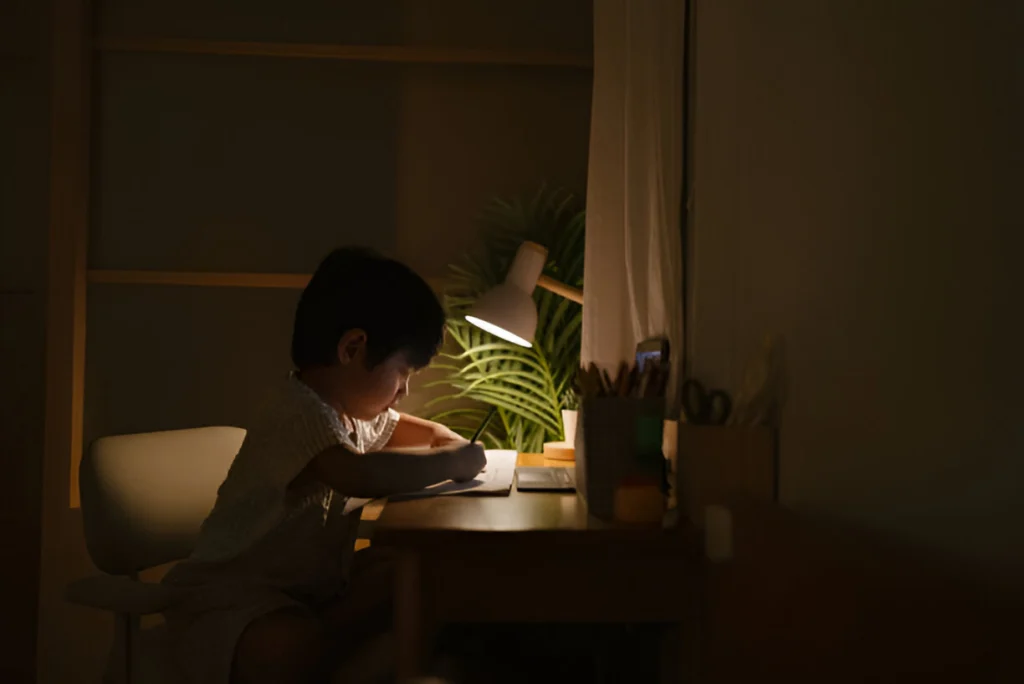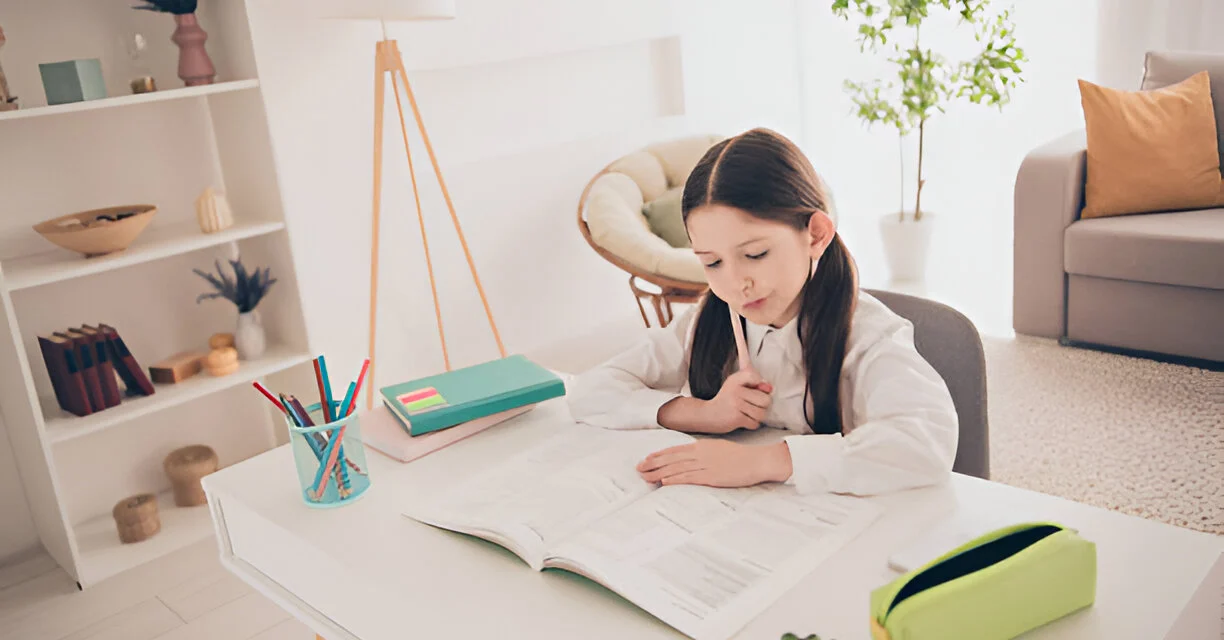Creating a good study environment at home is key for learning well. This article will show you nine effective steps to make a space that helps you focus and do well in school.
Key Takeaways
- Turn off devices and keep your study area private to avoid distractions.
- Use natural light and lamps for the right lighting in your study area.
- Choose a comfy chair and desk setup for better ergonomics.
- Use ambient noise machines or calming music to control noise levels.
- Add essential oils to help you focus and stay calm.
By following these nine effective steps, you can make a study-friendly home space. A study-friendly home helps you stay focused and do well in school. It’s about setting up a routine that improves your learning and mental health.
Create a Distraction-Free Zone
Turn Off Devices and Maintain Privacy
To make a productive study environment, cut out distractions. Turn off your phone and close tabs on your computer. Make sure your study area is free from distractions1.
Studies show that a comfortable, familiar, and quiet space boosts learning and focus1.
Establish a Dedicated Study Area
Choose a special spot in your home for studying1. Having a dedicated area can make you learn better1. Pick a quiet, well-lit spot away from busy areas. This ensures you can focus on your work.
Optimize Lighting Conditions
Maximize Natural Light
Use natural light to brighten up your study environment2. Studying in dim light can make you feel anxious and harder to remember things2. Place your desk near a window for natural light and better mood.
Use Lamps for Focused Illumination
Use lamps to add even lighting to your study area2. Bright lights can be distracting, especially when they reflect off screens2. Choose warm, adjustable lamps that light your space well without straining your eyes.
Ensure Comfort and Ergonomics

Choose a Supportive Chair
Get an ergonomic chair for back support3. Good chairs reduce back pain and help you stay productive3. Adjust the chair to keep your back straight and avoid discomfort.
Adjust Table Height and Seating Position
Make sure your desk is at the right height for your arms1. A good desk supports your needs and keeps things organized1. Find a setup that lets you work without straining your neck or shoulders.
Manage Noise Levels
Use Ambient Noise Machines or Calm Music
Reduce outside noise with ambient machines or music2. Noise can distract you, but white noise machines help you focus2. Try different sounds to find the right background noise for you.
Implement Sensory Aids
Diffuse Essential Oils for Focus
Use essential oils to improve your study environment2. Oils like rosemary and lavender can reduce anxiety and help you focus2. Use a diffuser or apply a few drops to your skin for a calm study space.
Create a Distraction-Free Zone
Getting rid of distractions is key for a productive study spot. Turn off your phone, stay off social media, and pick a special area for studying. Having a private, distraction-free area helps you focus better on your schoolwork4.
Turn Off Devices and Maintain Privacy
Kids often check their phones and social media a lot, which breaks their study flow4. Switching between homework and other stuff slows down their work and makes it less good4. To cut down on distractions, keep phones and iPods away, turn off instant messages, and block Facebook during study4.
Establish a Dedicated Study Area
Your study space should be the same every time. This way, you won’t waste time looking for things like pencils and calculators4. Sitting at a desk helps you stay focused better than lying down, which can make you just read passively4.
| Distraction-Free Strategies | Benefits |
|---|---|
| Turn off devices and maintain privacy | Reduces interruptions and improves focus |
| Establish a dedicated study area | Enhances productivity and concentration |
| Utilize the Pomodoro Technique | Boosts time management and reduces clutter |
| Organize study materials and tools | Promotes a clear and focused mindset |
By making a distraction-free and dedicated study area, you can work better and learn more. Using these tips helps you stay focused, organized, and meet your school goals.
“The key to focus is to create a distraction-free environment that allows you to immerse yourself in your work. This means eliminating potential sources of interruption and maintaining a consistent, dedicated study space.”
Optimize Lighting Conditions

Good lighting is key to a great study spot. Using natural light can help you stay focused and productive. Research shows5 that natural light wakes you up, while artificial light can make you sleepy. Placing your study area near a window is a smart move.
Artificial light also plays a role in your study setup. Experts6 say the best study room light is cool-toned, between 4000-6500K. Bright light boosts your brain and cuts down on tiredness. Desk lamps with 450 lumens help you concentrate better, and rooms need at least 1500 lumens for the best effect6.
Maximize Natural Light
- Put your study spot near a window for natural light5.
- Make sure your study area gets plenty of sunlight to stay alert and productive5.
- Use sheer curtains or blinds to control natural light and avoid glare or eye strain6.
Use Lamps for Focused Illumination
- Go for desk lamps with a cool white color, 4000-5000K, to boost productivity6.
- Desk lamps should be at least 450 lumens to help you focus and make fewer mistakes6.
- Combine room light (300 lumens) with task light (450-850 lumens) to avoid eye strain6.
Optimizing both natural and artificial light makes your study area better for learning7. Good lighting reduces eye strain, improves focus, and boosts study productivity6.
Ensure Comfort and Ergonomics
Creating a study-friendly home environment is more than just avoiding distractions. It’s key to focus on your comfort and ergonomics for long, effective study times. A good, adjustable chair is vital for good posture and less discomfort8.
Setting up your workspace right is important. Make sure your desk or table is at the right height. This lets your forearms rest comfortably, keeping your body in a neutral position8. Good ergonomics not only feels better but also helps prevent health issues like tendonitis and carpal tunnel syndrome8.
Choose a Supportive Chair
Find a chair that supports your lumbar area well and keeps your spine straight. Look for adjustable features like seat height and backrest. Try out different chairs to see what’s best for you and your study style9.
Adjust Table Height and Seating Position
Your desk or table should be at a height that lets your forearms be parallel to the ground. This keeps your elbows at a 90-degree angle, easing strain on your shoulders and neck9. If you use a laptop, a stand or riser can help keep the screen at or slightly below eye level, preventing neck pain9.
Don’t forget to take breaks to stretch and move. This helps with your comfort and ergonomics. By focusing on these, you can make a study space that boosts your productivity and health9.
Manage Noise Levels
Creating a study-friendly home environment means managing noise levels well. Ambient noise can distract you, making it hard to focus. Using ambient noise machines or calming music can help.
Studies show noise hurts academic performance. Students in noisy places might be years behind in reading10. Schools that fixed noise issues saw reading gaps close10. Long-term noise can also make visual tasks hard10.
There are easy ways to reduce noise and improve focus. Changing lights, using quiet HVAC, and updating insulation can help10. Closing doors, laying rugs, and decorating with fabric can also improve the sound environment10. Find the right noise level to boost your study performance.
Use Ambient Noise Machines or Calm Music
Ambient noise machines and calm music are great for managing noise. They can block out distracting sounds, creating a better sound environment. Try different levels and types of music to find what works best for you.
Background noise affects many kids, not just those with hearing loss11. It can impact kids with attention and behavior issues, language delays, bilingual kids, and those with auditory processing disorder11. Reducing background noise helps the whole class by making speech clearer, improving attention, and reducing frustration11.
Other strategies can also help manage noise in your study space. Using rugs, hanging soft materials, and adding soft tips to furniture can absorb sound11. By actively managing noise, you can create a better learning environment and improve your focus and success.
Implement Sensory Aids
Creating a study-friendly environment is more than just the right lighting and organization. Adding sensory aids can boost your productivity and focus. Try using an essential oil diffuser with scents like lavender, rosemary, or peppermint12. These smells can help improve your concentration and brain function, making your study space better.
Diffuse Essential Oils for Focus
Essential oils can deeply affect your mental state and focus13. People with sensory processing issues, affecting about 1 in 36 families in the U.S. with kids12, might find relief in certain scents. Look for oils that energize and uplift you, making your study area more supportive.
| Essential Oil | Potential Benefits |
|---|---|
| Lavender | Promotes relaxation and reduces stress |
| Rosemary | Enhances cognitive function and memory |
| Peppermint | Boosts alertness and mental clarity |
It’s important to find scents that suit you best. By using Sensory Aids like essential oils, you can make your study area more conducive to Concentration and success.
“Creating a sensory-friendly environment in the classroom may involve adjusting lighting, decluttering walls and decor, using carpets for noise reduction, adapting seating arrangements, implementing labels for organization, establishing quiet areas, providing fidget toys and tools, displaying visual timers, incorporating movement into lessons, and maintaining a consistent classroom routine.”13
Maintain Organization and Tidiness
Keeping your study area organized is key to staying productive and focused. By using desk organizers and filing systems, you can quickly find what you need. This saves time and helps you avoid distractions14. Also, cleaning your workspace regularly helps keep it organized and free from clutter14.
Use Desk Organizers and Filing Systems
Adding desk organizers and filing cabinets can make your study area more efficient. Keeping your pens, notebooks, and other supplies in order makes them easy to find. It also makes your space look nice and helps you relax14. Think about using wall shelves or pegboards to save space and keep your desk clear15.
Establish a Routine for Decluttering
Setting aside time each week or month for decluttering your study space boosts your productivity and focus15. Go through your stuff, toss what you don’t need, and make sure everything has a home14. A regular decluttering routine keeps your study area tidy, reducing distractions and improving your study experience15.
“A clean and organized space can do wonders for your productivity and mental well-being. Take the time to create a study-friendly environment that truly works for you.”
Remember, organization and tidiness are more than just looks. They are crucial for a study space that helps you stay focused and motivated15.
Develop Time Management Strategies
Effective time management is crucial for success in school. By scheduling study sessions and setting goals, you can use your time well. This helps you stay focused on your studies16.
Schedule Study Sessions and Set Goals
First, make a study schedule. Pick times each day or week for studying16. Remember, you have 24 hours, 1,440 minutes, or 86,400 seconds daily. Use them wisely16.
After scheduling, set clear goals for each study session. Goals might include solving a certain number of problems, reviewing a chapter, or outlining an essay16. Breaking tasks into smaller goals keeps you motivated and on track17.
Time management is not just about scheduling. It’s also about what tasks to prioritize1617. Use the Time Management Matrix to sort tasks. Focus on the most urgent and important ones16.
By organizing your studies and setting goals, you can manage your time better. This reduces distractions and leads to success in school17.
Also, try different time management methods like the Pomodoro Technique, Time Blocking, or Eat That Frog. These can boost your productivity and help you manage school tasks better18.
Optimize Desk Setup
The way you set up your desk can really affect how well you study. Make sure all your important tools and materials are easy to get to. This saves time and lets you focus better on your work19.
Also, using good cable management can hide messy cords and wires. This makes your workspace clean and free from distractions19.
Keep Essentials Within Reach
Set up your desk so that things you use a lot, like books and pens, are close. This simple trick saves time and keeps your mind sharp. It helps you stay focused and productive during study sessions19.
Hide Clutter and Cable Mess
Use tools like cord organizers to keep cables tidy. This makes your desk look better and helps you feel less stressed. A clean desk improves your focus and productivity20.
Adding things like whiteboards and healthy snacks can also make your study space better. They help boost your creativity and focus19.
By making your desk setup better and managing cables and clutter, you can make a great study space. A well-organized desk helps you stay focused and productive20.
Explore Alternative Study Spaces
Having a dedicated study area is good, but trying out different places can also help. Research shows that changing where you study can boost your exam scores21. Try studying in a quiet corner of your home or a park to avoid getting tired of the same spot. Switching up your study location can keep you focused and interested21.
Coffee shops are great for studying, but buying coffee there can add up21. Studying outside is nice for a change, but you might not have power or Wi-Fi21. Campus common areas are good for a quiet study spot21. Public transport is also a good place to study, especially if you’re always on the move21. Dorm rooms can work too, as long as you have a dedicated study area21. Bookstores are another good option for a quiet place to study and find books21.
Check out LifeAt for over 100 beautiful spaces to make your study area look great22. Drive & Listen has over 55 places for virtual car rides, and Magenta Lofi Player lets you build your own music room22. Websites like Flocus, I Miss My Office, and Virtual Cottage offer calming environments. You can also enjoy the Lofi Girl YouTube Live Stream for a soothing visual loop22.
Use tools like StudyWithMe.io for customizable Pomodoro timers, or Tomato Timers for study sessions22. Noisli and Noises Online have lots of background noises to help you focus22. myNoise offers high-quality sounds to create the perfect study atmosphere22.
| Platform | Features |
|---|---|
| LifeAt | Over 100 gorgeous spaces for crafting an aesthetic workspace22 |
| Drive & Listen | Over 55 destinations for virtual car rides around the world22 |
| Magenta Lofi Player | Allows users to interact with in-world elements to build custom music rooms22 |
| StudyWithMe.io | Customizable Pomodoro timers with a range of aesthetic backgrounds22 |
| Tomato Timers | Provide customizable Pomodoro intervals and breaks for study sessions22 |
| Noisli | Over 25 premium background noises to mix and match for a personalized soundscape22 |
| Noises Online | 30 different sounds to curate ideal background noise settings for studying22 |
| myNoise | Hundreds of high-quality original recordings for creating an immersive study environment22 |
Study-Friendly Environment
Creating a study-friendly environment is more than just removing distractions. It’s about making a space that inspires and motivates you to do your best. Personalizing your study area can greatly improve your academic performance and well-being23.
Personalize Your Space for Motivation
Add things that show your unique interests and personality. Hang artwork, inspirational quotes, or plants that make you happy and calm23. These personal touches make your study space feel like home, where you enjoy spending time23.
Display Awards and Accolades
Displaying your past achievements and awards boosts your motivation23. Seeing your hard work and success in your study area reminds you of your abilities. It motivates you to keep striving for the best23.
| Personalization Strategies | Motivational Benefits |
|---|---|
| Artwork, inspirational quotes, or plants | Cultivate a sense of comfort and connection to your study space |
| Display of academic awards and achievements | Serve as a source of positive reinforcement and motivation |
| Organize furniture and layout to minimize distractions | Enhance focus and concentration during study sessions |
| Incorporate personal touches that reflect your interests | Make your study environment feel more inviting and enjoyable |
By personalizing your study-friendly environment, you create a space that boosts focus and motivation23. This positive reinforcement can be a game-changer for your academic success23.
“A personalized study space can be a powerful tool for motivation and success. It’s a reflection of your personality and a constant reminder of your capabilities.”
So, take the time to personalize your study area. Let it be a source of motivation and positive reinforcement throughout your academic journey23.
Portable and Compact Solutions
If you have little space at home, Compact Desks and Portable Solutions are great. Wall-mounted desks and portable bed desks let you set up a study area without using much floor space. They’re perfect for small apartments or shared living spaces.
Wall-Mounted Desks
Wall-mounted desks are great for saving space. They can fold up or be tucked away when not in use. This keeps your room tidy. These desks fit well in small corners or alcoves, turning unused wall space into a study area24.
Portable Bed Desks
Portable bed desks are another smart choice for a study-friendly home. They’re light and easy to move, letting you work from your bed or any cozy spot. They often have built-in storage and adjustable heights, making them useful in small spaces24.
Choosing a wall-mounted desk or a portable bed desk can help you use your space better. These Portable Solutions and Compact Desks let you create a study area that fits well in your home. Their design and features make them great for small spaces.
| Brand | Product | Sustainability Features |
|---|---|---|
| Nimble | Portable Chargers | Rechargeable, made from recycled materials25 |
| Juice | Eco-Friendly Portable Chargers | Sustainable charging solutions, upcycled materials25 |
| Gomi | Sustainable Tech Products | Upcycled plastic and e-waste, eco-friendly design25 |
For a study-friendly space, you also need sustainable charging options. Brands like Nimble, Juice, and Gomi offer Portable Solutions that are good for the planet. They use recycled materials and responsible manufacturing to cut down on e-waste25.
Adding these space-saving and eco-friendly options to your home can make a study space that’s both productive and beautiful. It meets your needs without making your living area look or feel less functional2425.
Conclusion
Creating a study-friendly environment at home is key for success. By following the nine steps in this article, you can make a space that helps you focus and learn better26. This will improve your productivity and learning experience.
Investing in a good study area can help you reach your goals. It makes you perform better in school and keeps you motivated27. Make your space your own, add things that inspire you, and celebrate your wins to make it even better28.
Building a dedicated study area at home is a smart move for your future. It shows you’re serious about learning and growing. Follow the steps in this article to turn your home into a place of study-friendly success.





